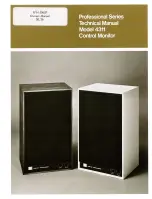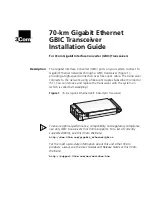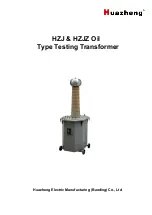
Print Date 04/01/11 Page 6 of 42 E2165-00MA-04
1.1.2 : Main and Input/Output Boards
The Main Board contains all the basic baseband input circuitry (Composite/MPX, RDS, SCA and
Mono) the modulator and associated frequency synthesiser, the main hardware control and monitor
microprocessor and all connections to other boards, modules and options within the Exciter.
The associated Input/Output Board connects to a socket on the Main Board and carries all the parallel
and RS232 serial control and monitoring connections to a 25 way ‘D’ socket and a 9 way ‘D’ plug
respectively, on the rear panel. This Board provides protection and filtering for all these input/output
circuits as well as the ‘open collector’ output transistors for the parallel status output connections.
All the baseband inputs to the Main Board (via the rear panel connectors) are summed together before
being applied to the direct frequency modulator (i.e. modulation is directly applied to the 87.5 to
108MHz oscillator). The RDS/SCA inputs are all unbalanced and have 75
Ω
or 10k
Ω
input impedance
setting options. The Mono signal has balanced (600
Ω
or 13.3k
Ω
) and unbalanced (600
Ω
or 20k
Ω
)
setting options. The Composite input has balanced (75
Ω
or 13.3k
Ω
) and unbalanced (75
Ω
or 20k
Ω
)
setting options. The options are set using links on the Main Board. All these inputs have separate
input level setting controls adjustable via access holes on the rear panel. Additionally, the Mono signal
input can have 25, 50, 75uS or no pre-emphasis applied, this again being set using links on the Main
Board.
There is also a Composite output on the rear panel (with 75
Ω
output impedance). This only provides
an output from an optional module, which generates a composite/mpx signal from an input to that
module (the Stereo Encoder /S option, or the MPX/Composite /M option for example). This internally
generated signal can be directed to the input summer (to modulate the Exciter directly) by having the
rear panel ‘Loop’ switch in the upper ‘Int’ position. With the switch in the lower ‘’Ext’ position the
internally generated signal is normally taken out of the Composite output and directed via external
units (such as an RDS generator) back into the Exciter’s main Composite input.
The direct frequency modulator uses a low microphony transmission line resonator in a low noise
transistor oscillator circuit. DC coupling of the audio modulating signals, right through to the final
modulating varicap diodes, gives optimum frequency response and stereo separation over the whole
audio range. Extra tuning varicap diodes, controlled by dc voltages derived from an output frequency,
software based look-up table, give high linearity and near constant deviation sensitivity over the whole
output frequency range. The output of the modulator is harmonically filtered, buffered and amplified to
provide a low level drive for the 150/300W Amplifier Module (section 1.1.3).
The output frequency of the Exciter is set by a phase lock loop controlled by the Main Board
microprocessor. The loop filter output controls the main tuning varicap diodes of the oscillator. This
filter has two software switched time constants. A very long time constant is selected when the loop is
settled in its normal modulating mode (optimising low frequency audio performance). A much shorter
time constant is temporarily selected when the frequency is being changed, to ensure frequency
changes can be made in a relatively short period. Whilst such changes are being made (or if the loop
is out of lock for any other reason) the low level drive from the Main Board and the 150/300W Amplifier
are both muted.
The output frequency is locked to a highly stable 12.8MHz Temperature Controlled Crystal Oscillator
(TCXO) on the board. If required, this TCXO can be separately locked to an external 10MHz standard.
This is done using a second phase lock loop, again controlled by the Main Board microprocessor.
Locking to the external standard happens automatically if a signal of the correct frequency and level is
applied to the rear panel External Standard input.
The microprocessor on the Main Board provides all control and monitoring of the hardware on the
board, including analogue to digital conversion of power supply and modulation levels. It also
interfaces, via serial data links, with other hardware control microprocessors on the Amplifier Control
Board and optional modules (RS485 bus – sections 1.1.3, 1.1.5, 1.1.6 and 1.1.7) and on the Front
Panel module (separate dedicated bus – section 1.1.1). The seven channel frequencies and settings
of any optional modules are stored in its non-volatile ‘flash’ memory.
A separate hardware ‘watchdog’ circuit monitors the running of the microprocessor’s program and
provides warnings (on board led, to Front Panel and to rear panel output) if the program fails to run,







































